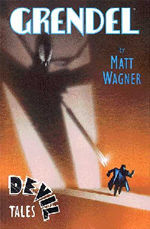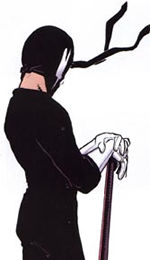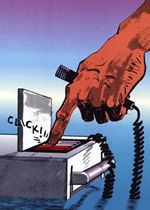>> The Friday Review: Pubo
>> The Friday Review: Get Your War On
More...

 Writer/Artist: Matt Wagner
Writer/Artist: Matt Wagner
Letterer: Bob Pinaha
Colours: Bernie Mireault
Collecting GRENDEL volume 2, #16-19.
Price: $9.95
Publisher: Dark Horse Comics
ISBN: 1569714282
I first encountered Matt Wagner's signature creation Grendel as an overly serious and rather pretentious teenager in the late eighties. My all important self-image was one of a young and unconventional free thinker to whom the mainstream was something to be religiously shunned - and my choice in reading matter could be no exception to that rule.
Consequently, I was drawn to the independent racks of my local specialist comics store out of a snobbish disdain for the vast bulk of the Big Two's output rather than through any real intellectual appreciation of the material that resided there, much as I liked to think otherwise. A dark period in my personal development indeed, although on the plus side it did mean that in later years I could enjoy a comics collection well stocked with titles like AMERICAN FLAGG, ESPERS and NEXUS.
And then of course, there was GRENDEL.
It was the name that caught my eye. Grendel for me meant the monstrous antagonist of BEOWULF, and I was fascinated as to what relationship the sleek black figure on the cover of this apparently well regarded book might have to the creature of legend. And then there was the advisory label, which promised scenes of explicit sex and violence. As you can imagine, it was an easy sell.
Grendel debuted in an eight page story by Wagner in the COMICO PRIMER back in 1982, which was followed by a short lived black and white series of three issues the following year. This first series of GRENDEL was nothing special. It was a clumsy, none too subtle inversion of the traditional pulp superhero/supervillain dynamic, in which Hunter Rose was the suave, debonair master criminal who took on the identity of Grendel in order to anonymously control organised crime and do battle with his brutal arch-nemesis, the werewolf Argent.
The series was soon abandoned by Wagner, who became bored with the concept, but he later revived and reworked Grendel in his groundbreaking first series of MAGE as a series of illustrated prose pieces - at the end of which he killed off the character, supposedly for good. These pieces were later collected by Comico as GRENDEL: DEVIL BY THE DEED to great acclaim, prompting the publisher to ask Wagner for more. Although initially reluctant, Wagner finally agreed, but not without a change of direction and focus.
Stepping back from the art chores to concentrate on the writing, Wagner brought on board a series of talented young artists to chronicle the evolution of the Grendel myth. Leaving the Hunter Rose story behind, Wagner portrayed Grendel as a something akin to a spirit, in the Hegelian sense of the word - a 'meme' that could infect and consume not just individuals, but eventually, whole societies. GRENDEL became an extended examination of aggression and violence, and the impact they have on both victim and perpetrator.
 It was also one of the most successful and best remembered independent comic books of the eighties. Although the bankruptcy and subsequent collapse of Comico meant GRENDEL languished in copyright limbo for several years, the publishing rights were eventually acquired by Dark Horse, which published the conclusion to Wagner's storyline (as GRENDEL: WAR CHILD), and is currently reprinting vol.2 in its entirety.
It was also one of the most successful and best remembered independent comic books of the eighties. Although the bankruptcy and subsequent collapse of Comico meant GRENDEL languished in copyright limbo for several years, the publishing rights were eventually acquired by Dark Horse, which published the conclusion to Wagner's storyline (as GRENDEL: WAR CHILD), and is currently reprinting vol.2 in its entirety.
DEVIL TALES reprints issues #16-19 of GRENDEL vol.2, first published in 1988, which saw Wagner's return to the series as illustrator to tell two out-of-continuity tales of the Hunter Rose Grendel. Neither story deals with Grendel directly, with Hunter Rose relegated to a strictly secondary role. The 'spirit' of Grendel, however, looms ominously over both stories, which focus on characters peripheral to events described in DEVIL BY THE DEED - characters that by chance become embroiled in the world of Grendel and find themselves destroyed in his wake.
Grendel is portrayed here as a mythic character akin to a force of nature. In terms of the ongoing series, these four issues dovetailed neatly with the transition of the Grendel 'spirit' from a ghost of the past that haunted the individual to something more pervasive and primal, capable of affecting society as a whole. v The framing device Wagner employs to tell both stories makes use of a character from the previous two arcs - the now retired police detective Albert Wiggins - who is earning a living by penning tales of the first Grendel (the only one up to this point that he's never known). Although the bridging sequences are purely functional in terms of plot or dialogue, they do provide an early illustration of Wagner's skilful and frequent use of the page as a panel in itself. Indeed, although Wagner tells two very capable and entertaining tales in this volume, it can also be viewed as a superb introduction to Wagner's innovative layouts and storytelling techniques - more on which later.
The first story, 'Devil Tracks', concerns a young police lieutenant who overhears his Captain accepting a bribe, and, deciding to investigate further on his own time, slowly unravels a labyrinthine plot of greed, jealousy and murder that leads, inevitably, to Grendel. A dense, intricate crime thriller told entirely through dialogue, 'Devil Tracks' has a very cold, precise feel to it. Characters are kept to a simple, story driven minimum, with Lieutenant Polk particularly effective as the innocent, almost Hitchcockian protagonist. Wagner handles the mounting intrigue of Polk's investigation brilliantly, taking the audience through a number of twists and turns, none of which feel forced or contrived.
 The story is beautifully complimented by Wagner's art. He uses square panels in a rigid, brick like grid, enhancing the feeling of intricacy and complexity perfectly. At twenty-five panels per page in places, the story even looks convoluted. Tellingly, the only time the narrative steps outside this pattern is when Grendel appears - as if the character were too large to be contained by the story. The climax, in which Grendel and Argent fight around the block-like panels of the main narrative, is wonderfully realised.
The story is beautifully complimented by Wagner's art. He uses square panels in a rigid, brick like grid, enhancing the feeling of intricacy and complexity perfectly. At twenty-five panels per page in places, the story even looks convoluted. Tellingly, the only time the narrative steps outside this pattern is when Grendel appears - as if the character were too large to be contained by the story. The climax, in which Grendel and Argent fight around the block-like panels of the main narrative, is wonderfully realised.
By contrast the second tale, 'Devil Eyes', is a much more fluid, simple affair. It tells the story of gangland snitch Tommy Nuncio, the unfortunate individual chosen to feed the cops misleading information on the Anson Reynolds hit, as detailed in DEVIL BY THE DEED, as part of a ploy to publicly humiliate and discredit Grendel's foe Argent. To those familiar with DEVIL BY THE DEED, Nuncio's fate will already be known, albeit only as a footnote. 'Devil Eyes' details his final days entirely from his own perspective, revealing how he came by the fateful information, and documenting his mental disintegration as Grendel draws close.
This time, the layout takes the form of a single row of tall, thin panels of uniform height, accompanied by both the first person narrative of Nuncio, and Wiggins' scribbled story notes in the white spaces above and below the panels. Compared to the convoluted approach used in the previous tale, 'Devil Eyes' reads in a very 'route one' fashion, which suits the introspective nature of the story. The art, meanwhile, takes on an increasingly expressionistic style as Nuncio's paranoia and desperation mount. Eisner award winner Bernie Mireault's colouring comes into its own here, perfectly complimenting Wagner's exaggerated lines by mirroring Nuncio's often fevered emotions and moods.
The exception to this rule is, once again, whenever Grendel invades the story. While Nuncio's state of mind distorts and exaggerates both his appearance and his surroundings, the figure of Grendel, when he appears, remains cool, clear and undistorted.
I always enjoyed GRENDEL of course (I couldn't afford to buy anything I didn't enjoy back then), but it took me a while to appreciate just how much of an innovative talent Matt Wagner was - and just what an important and special series he had created in GRENDEL. Wagner, despite producing a body of critically acclaimed work for DC on company-owned properties like BATMAN and THE DEMON, is still best known for his two creator owned properties, GRENDEL and MAGE.
Ironically, GRENDEL has become very much a part of the comics mainstream - with spin-offs, merchandising, and a home at one of what is now the Big Four publishers - but luckily I stopped caring about things like that a long time ago. Nowadays, the sheer amount of GRENDEL material on the shelves can be off-putting to the new reader; but although the most obvious jumping on point, DEVIL BY THE DEED, remains sadly out of print, DEVIL TALES works as a great introduction to both the series itself, and to the work of one of the medium's great innovators of the last twenty years.

This article is Ideological Freeware. The author grants permission for its reproduction and redistribution by private individuals on condition that the author and source of the article are clearly shown, no charge is made, and the whole article is reproduced intact, including this notice.


